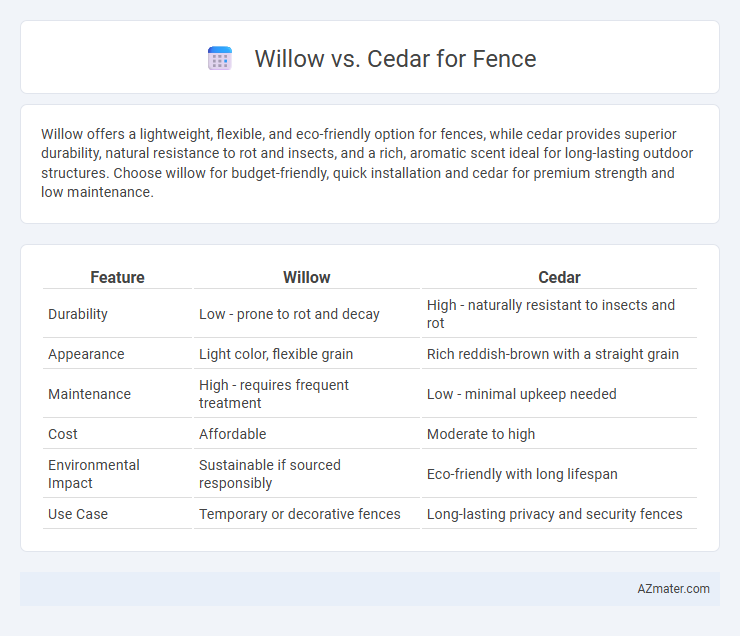Willow offers a lightweight, flexible, and eco-friendly option for fences, while cedar provides superior durability, natural resistance to rot and insects, and a rich, aromatic scent ideal for long-lasting outdoor structures. Choose willow for budget-friendly, quick installation and cedar for premium strength and low maintenance.
Table of Comparison
| Feature | Willow | Cedar |
|---|---|---|
| Durability | Low - prone to rot and decay | High - naturally resistant to insects and rot |
| Appearance | Light color, flexible grain | Rich reddish-brown with a straight grain |
| Maintenance | High - requires frequent treatment | Low - minimal upkeep needed |
| Cost | Affordable | Moderate to high |
| Environmental Impact | Sustainable if sourced responsibly | Eco-friendly with long lifespan |
| Use Case | Temporary or decorative fences | Long-lasting privacy and security fences |
Willow vs Cedar: An Overview
Willow and cedar are popular choices for fencing, each offering distinct properties: willow fences are lightweight, eco-friendly, and provide a rustic aesthetic, while cedar fences are renowned for durability, natural resistance to decay and insects, and rich color tones. Cedar contains natural oils that help prevent rot, making it ideal for long-lasting outdoor structures, whereas willow is more prone to weathering without regular maintenance. Choosing between willow and cedar depends on the desired fence lifespan, maintenance commitment, and visual style preferences.
Durability Comparison: Willow and Cedar Fences
Cedar fences are renowned for their exceptional durability, naturally resisting rot, decay, and insect damage, which makes them ideal for long-lasting outdoor use. Willow fences, while aesthetically pleasing and lightweight, tend to be less durable and more susceptible to weathering and pest infestations, requiring more frequent maintenance. In terms of longevity and structural integrity, cedar clearly outperforms willow in fence applications, offering a sustainable and resilient option for outdoor boundaries.
Weather Resistance: Which Wood Performs Better?
Cedar outperforms willow in weather resistance due to its natural oils that repel moisture and resist decay, mold, and insect damage. Willow, being softer and less dense, is more prone to rotting and warping when exposed to prolonged moisture and harsh outdoor conditions. For long-lasting fence durability, cedar remains the superior choice as it withstands rain, snow, and UV exposure more effectively.
Aesthetic Appeal: Willow vs Cedar Fence Looks
Willow fences display a natural, rustic charm with flexible, interwoven branches creating a warm, textured appearance ideal for organic landscapes. Cedar fences offer a sleek, uniform look with rich reddish-brown hues that age gracefully to a silvery gray, enhancing curb appeal in traditional and modern settings. Comparing the two, willow provides a softer, more casual aesthetic while cedar delivers enduring elegance and strong visual impact.
Maintenance Requirements: Willow vs Cedar
Willow fences require frequent maintenance due to their softer wood, which is more prone to rot and insect damage, necessitating annual inspections and treatments with wood preservatives. Cedar fences offer superior durability with natural oils that resist decay and pests, reducing the need for frequent upkeep and typically requiring maintenance only every few years. Choosing cedar significantly lowers long-term maintenance costs and effort compared to willow fences.
Cost Analysis: Fencing with Willow or Cedar
Willow fencing typically offers a more budget-friendly option due to its rapid growth and abundance, resulting in lower material costs compared to cedar. Cedar fencing, while higher in initial expense, provides superior durability and natural resistance to rot and insects, potentially reducing long-term maintenance and replacement costs. Evaluating both upfront investment and lifecycle expenses is crucial when choosing between willow and cedar for fencing projects.
Environmental Impact: Sustainability Factors
Willow fences offer higher sustainability due to rapid growth and efficient carbon sequestration, making them an eco-friendlier choice compared to slower-growing cedar. Willow's biodegradability reduces landfill waste, while cedar's natural oils provide durability but contribute to longer decomposition times. Harvesting willow requires less energy and causes minimal habitat disruption, enhancing its environmental appeal over cedar in sustainable fencing options.
Pest and Rot Resistance: Strengths of Willow and Cedar
Willow wood offers moderate pest resistance but is more prone to rot compared to cedar, making it less durable in damp conditions. Cedar is naturally high in oils and tannins, providing superior resistance to pests like termites and decay fungi, ensuring longer-lasting fence durability. The strength of cedar lies in its ability to withstand insect damage and moisture, making it an ideal choice for outdoor fencing applications seeking longevity.
Installation Differences: Working with Willow and Cedar
Willow wood is lightweight and flexible, requiring gentle handling and pre-drilling for fasteners to avoid splitting during fence installation, whereas cedar is denser and more durable, allowing for easier nailing and longer-lasting structural integrity. Cedar's natural resistance to rot and insects reduces the need for chemical treatments, simplifying installation and maintenance compared to willow, which may require additional protective measures. Working with cedar typically demands standard woodworking tools, while willow's softness and pliability may necessitate specialized equipment to achieve precise cuts and secure fittings.
Best Choice for Your Fence: Willow or Cedar?
Cedar offers greater durability and natural resistance to rot and insects, making it an ideal choice for long-lasting fences. Willow, while more affordable and eco-friendly, lacks the same level of weather resistance and may require more maintenance. For a balance of aesthetics, longevity, and low upkeep, cedar is generally the best choice for fencing.

Infographic: Willow vs Cedar for Fence
 azmater.com
azmater.com